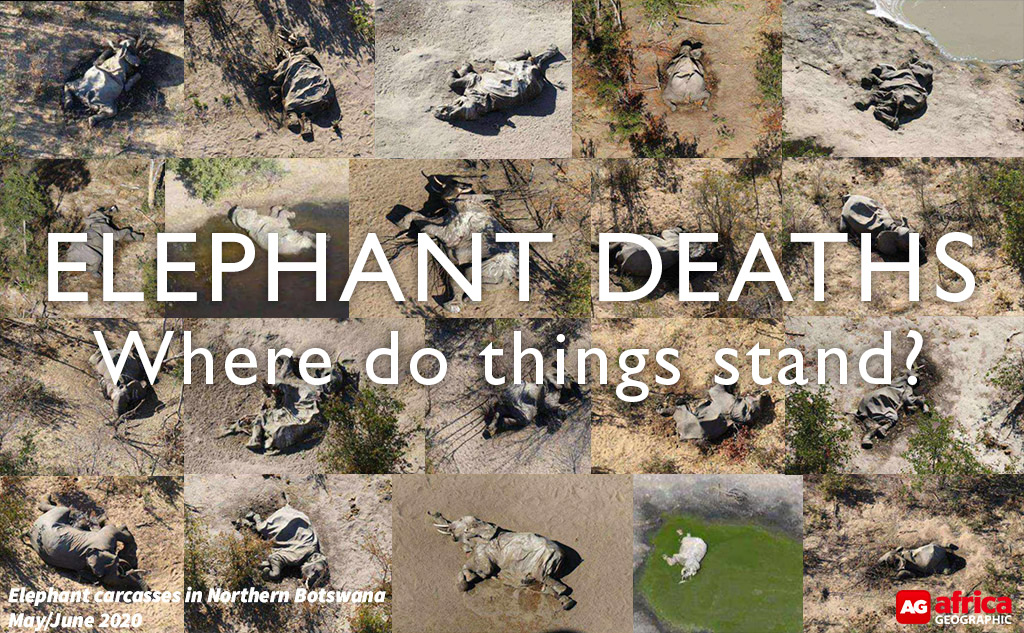
Originally published in Talking Humanities of the University of London, School of Advanced Study and Africa Sustainable Conservation News
Professor Keith Somerville investigates the mysterious deaths of more than 300 elephants in Zimbabwe and Botswana.
The discovery of the carcasses of 22 elephants near Hwange National Park in western Zimbabwe in early September has reactivated concern in the region and among those interested in elephant conservation that we still don’t know what killed 281 elephants in the Seronga district of Botswana’s Okavango Delta between March and June this year.
The Zimbabwe deaths occurred in a relatively restricted area in the Pandamasuwe Forest in western Zimbabwe, between Hwange NP (its largest fully protected conservation area) and Victoria Falls. All the dead elephants were young, under 18 years of age, according to the Zimbabwe Parks and Wildlife Management Authority (Zimparks). A spokesperson for Zimparks, Tinashe Farawo, told the media that all the elephants still had their tusks, ruling out poaching as a cause of death.
Zimbabwe has a recent history of the use of cyanide by poachers, who poison waterholes used by elephants. He added that there was no evidence that they had been killed by the disease anthrax, which is found in wild ungulates and livestock in southern Africa. Final tests are awaited to find a specific cause of death, though naturally occurring toxins in plants or contaminated water have not been ruled out, nor have so far unidentified bacterial infections.
Zimbabwe has between 80,000 and 86,000 elephants – about 55,000 of them in and around Hwange NP. They are part of the estimated 220,900–240,000 elephants to be found in the Kavango-Zambezi Transfrontier Conservation Area, KAZA, which includes regions of Angola, Botswana, Namibia, Zambia and Zimbabwe.
Botswana has the largest elephant population there and in Africa as a whole, with between 130,000 and 150,000, numbers fluctuating as elephants move across the KAZA region to find water and food. Herds move across the region throughout the year, and it is not possible to give a definitive population figure for any one country, as numbers change with the seasons.
The Zimbabwean deaths are worrying but not as extensive as the demise of hundreds of elephants in the northern Okavango Delta earlier this year. These were first reported in May, when the southern African media said that by early July, 400 carcasses of elephants that had died suddenly had been discovered around the Seronga region of the northern Delta. In what is known as the Panhandle – none had their tusks removed, and they did not appear to have died of starvation or thirst.
Poaching using poisons like cyanide and strychnine and anthrax were ruled out by laboratory tests early on. Tests also ruled out the nine most common pesticides and other agricultural chemicals used by farmers, and which have been used to poison wildlife. The environment ministry has also said that Encephalomyocarditis virus, which is an acute viral disease, another possible cause, also has been eliminated as the cause of deaths.

After initial testing in Botswana, samples from the elephants were sent to South Africa, Zimbabwe, the US and Britain for more extensive tests. These confirmed that poison, anthrax, dehydration and starvation could be ruled out. The Botswana Ministry of Environment, Natural Resources Conservation and Tourism (MENT) has said that the original estimates above 375 elephant deaths, reported by the NGO Elephants Without Borders (EWB) was incorrect. EWB and the government have a history of conflict over the conservation, elephant numbers and poaching levels in northern Botswana. It was now known that 281 had died from unexplained causes. Many were found dead on their knees, indicating sudden deaths rather than the long-drawn-out deaths that occur with starvation or lack of water.
The testing of samples outside the region has been slow. The Botswana environment ministry explained this as being a result of the strain placed on testing centres across the world by Covid-19 and its effects on international shipment of samples from the elephants, which has slowed the whole process.
No other carcasses suspected to be linked to the Okavango deaths have been found since July. However, those in Zimbabwe will cause renewed concern about the number of unexplained deaths in the KAZA area. Suspicion, according to the Botswana environment ministry, now centres on potentially lethal naturally-occurring toxins. But an experienced conservationist working in Botswana said a specific cause might not be identified as ‘the chances of definitive identification of a natural toxin are practically zero unless it is one of the known cyanotoxins, and even they are all challenging and expensive to analyse – even in good samples. Rotting elephant is not a good sample.’
Cyanotoxins include cyanobacteria (blue-green algae) which can occur in waterholes and especially after droughts – the region had a three-year drought which ended earlier this year. This toxin has been implicated in the deaths of livestock following droughts. Conservationists hope that these deaths are isolated and are not indicative of a virus that can be transmitted between elephants.![]()
Professor Keith Somerville is a senior research fellow at the Institute of Commonwealth Studies (ICWS), part of the School of Advanced Study (SAS), University of London. He is a Member of the Durrell Institute of Conservation and Ecology at the University of Kent where he teaches at the Centre for Journalism and is editor of the Africa Sustainable Conservation News website. He is the author of Ivory. Power and Poaching in Africa.
To comment on this story: Login (or sign up) to our app here - it's a troll-free safe place 🙂.![]()








